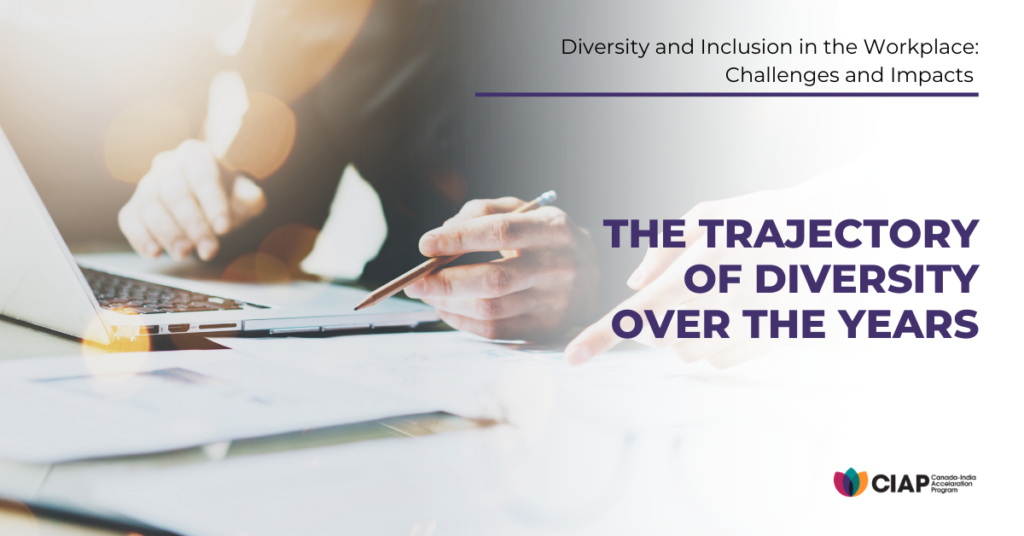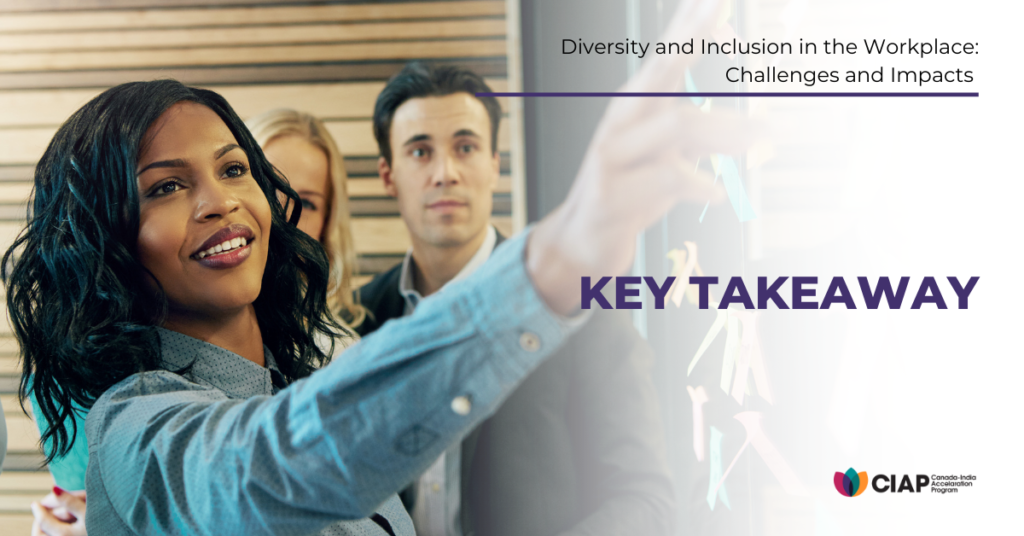Diversity is the genesis of an organization’s growth and creating a competitive edge. However, diversity and inclusion might not mean much, without meticulous planning, policies, and strategies in place. It is slow and periodic but should be an ongoing process.
We at the Canada-India Acceleration Program, resonate deeply with diversity and equal opportunity initiatives and support women entrepreneurs and bilateral relations between Canada and India.
So how do you catapult towards growth through inclusion and increasing diversity? Let’s take a look at the impact of diversity and inclusion on an organization and some of the challenges and opportunities that come with it.
The Trajectory of Diversity Over The Years

The voices on diversity and inclusion in every industry are rising. Awareness campaigns, brand collaborations, culture representation, hiring practices, inclusive policies, and many other initiatives are happening at every level.
While it feels like we just started this transition in the last decade, the debate on diversity in the workplace started during the second world war. Legislation was first made in 1965 to formally address the concerns and discussions on discrimination primarily based on ethnicity, race, gender, and sexual orientation. The Civil Rights movement added pressure and changes slowly started taking place.
Improved Accountability and Expectations
The economic impact became evident and inclusion became an imperative for companies to grow and thrive. Organizations started preemptively creating business cases to improve diversity efforts. Efforts and accountability are now quantified and measured against metrics like the retention rate, revenue generation, the productivity of employees, and brand image.
While it was a great beginning, technology improved and business borders started to blur. Diversity initiatives needed to be more tangible, beyond just affirmative action. Programs and perks to improve work-life balance and quality of life were the need of the hour. Flexible work schedules, daycare facilities for single parents, relaxed dress etiquette, partnership opportunities, retirement and investment plans and similar offerings became bigger players in the space.
D+I in International Expansion
Today, globalization of businesses has moved past setting up physical offices as e-commerce and remote working has taken off. An effective way to leverage expansion efforts is by diversifying your workforce. It brings in skills that are otherwise hard to find. Diversifying talent means broadening perspectives are indispensable assets for success.
As a business leader, it’s important to always have this on your radar and reassess strategies to avoid slipping through the cracks.
Common Hurdles Faced in Addressing Equality

As technology continues to be a disruptor, the context of diversification is quite layered and interconnected. It is now beyond the realms of culture, race, gender, and race. Failing to understand the complexities of what can sometimes feel like an overwhelming concept brings challenges and hurdles.
The idea is to address equality across the board and dodge the common pitfalls. Let’s take a look at some of the most prominent areas:
- Incomplete Diversity Strategies in Hiring: Talent management and HR teams are the port of entry for diversification. While having policies to be inclusive in place is a great start, it is not enough if it isn’t fully encompassing. Equal work opportunities at the workplace need to include acquired diversity groups, meaning – socioeconomic backgrounds, culture, disability, all religious or political preferences, or sexual orientation.
- Lack of Tools + Resources: When you’re first starting out with smaller teams and tighter budgets, aspects of diversification can be missed. You may feel it’s too early in your startup’s journey to really begin doing your part in this conversation. That being said, by focusing on educating both yourself and your team from early on, the foundation for continuing to grow your business in an inclusive manner will be established.
- Leadership Participation: Representation at the top impacts brand image and the conviction an organization has towards diversity. It is important to enable a non-discriminate environment across all levels and teams. Addressing the full scope of D+I while formulating strategies is another challenge companies face. Leaders need to believe and strive towards a trickle-down effect.
To read more on the subject, our blog Women and Entrepreneurship: The Impacts and Challenges covers the challenges that come with an increased presence of women in leadership.
Finding Opportunities in Overcoming Challenges

The bright sides to the conversations around a difficult but important topic of D+I, are the innovation, technology, and companies built based on this. Adding tech tools to optimize your strategy can catapult towards positive growth and impact.
Here are some of our recommendations:
Veza Global, a company from CIAP Cohort 2, helps companies with a host of services that help embed EDIB(Equity, Diversity, Inclusion and Belonging) across their operations. Like the EDIB assessment for overall performance score on inclusivity; EDIB Audit that surveys focus groups to understand companies policies; Advisory; and also education through their EDI course.
The Applied platform helps you to remove biases around the hiring process. Some key strategies include removing job applicant information and randomizing the order to avoid racial profiling. It displays application responses from all candidates rather than having recruiters review one full application at a time.
Allie is a chatbot that integrates Slack into its platform. It sends employees D+I surveys, so workers can weigh in on the company’s inclusion and culture. Employees can share feedback and suggestions about improving D+I through their feedback feature and categorize them as “exclusions” or “stereotypes.”
Gapsquare’s software helps highlight compensation inequities within organizations. It uses workforce data like job titles and performance along with diversity information such as disability and age to flag wage inequalities and encourages fair pay practices.
If you’re interested in finding more tools along these lines, this list compiled by TechTarget may be helpful.
What are the Effects of Increasing Diversity

- Improved Perspectives: Our culture and background bring innate wisdom, which is the biggest impact a healthy mix of diversity brings to the table. Broader perspectives and problem-solving capabilities add up to impact businesses positively.
- Improved Organizational Culture: A strong D+I environment enables employees to interact and learn from each other’s strengths, cultures, and backgrounds, which is invaluable to both the organization and employees. It naturally leads to more welcoming and upbeat work culture.
- Improved Marketing Strategies: A team with diverse backgrounds formulate stronger marketing and product development strategies. Understanding the nuances and thereby defining and speaking to the target audience better. Creative problem-solving capabilities also improve exponentially.
Key Takeaway

Studies and research, point positively towards the impact of increasing diversity and inclusivity at workplaces. While it is a qualitative metric that needs to be weighed through quantifiable strategies, and the implementation is slower than ideal, it is a crucial area to focus on.
Companies need to leverage this for international expansion but, considering the blurring business boundaries, even domestic markets need it just as much. There are inherent challenges due to the nature, complexity, and sensitivity of the territory, however, there’s nothing we cannot solve with an open mind and dedicated effort.
How do you approach prioritizing diversity and inclusion as a business leader?

Rohini
31 August 2022 at 2:55 amWe agree that one of the setbacks for businesses is finding relevant tools to hire a diverse workforce. With advanced HR tech tools, firms can employ talented employees.